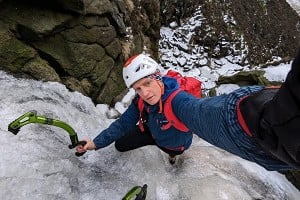
- More information about the new range of DMM axes can be found on their website here.
- Also see this UKC comparison review: Top Ice Axes.
Axes on Test:
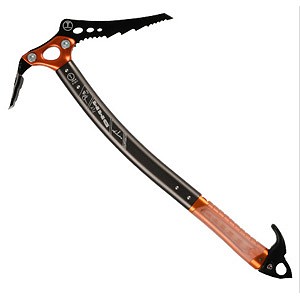
|
|
DMM Fly:
|
DMM Apex:
|
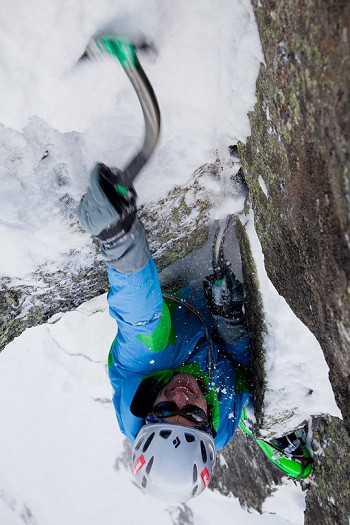
Ice axes are possibly the piece of climbing gear that have evolved the most over recent times, with ever more curved, contoured and seemingly wacky designs appearing every season. Away from the very wrong side of vertical (and horizontal) routes of the superheroes, the new techniques and designs have cascaded (sorry) down to the new breed of all-round axes, including DMM's new Apex, and a revision of their old favourite – the Fly.
General features:
Both the Apex and new Fly share the same construction of shaft, headset, pick and handle, and both come fitted with handrests in place of leashes.
Shaft:
The forged headset and tubular shaft of the old Fly, and one-piece forged shaft of the Rebel have been replaced by a new design using a forged headset, a tubular upper shaft, and a forged handle section, all joined by double rivets. While seemingly complex, this three-piece design works very well in practice. The headset uses the tried and tested original Fly design, the tubular upper is lightweight and comfy to hold when daggering and the forged handle solidly mounts the upper axe, hand-rests (see below), the fully integral low profile (flush to the shaft) plastic grip and the spike. Using a separate handle section (as opposed to a one piece tube) also interrupts vibrations travelling down the shaft, so there is noticeably less 'buzz' transmitted when the pick connects with the (wrong) target, but a good placement feedback feel remains. Last, for any Rebel users out there – the paintjob is much much tougher!
Headset:
The basic headset design is that of the original Fly – unchanged on the new Fly, and just a slightly different shape on the Apex. Made from a single piece of alloy with a slot cut into it to accept the pick, the nuts on the two bolts are recessed so only a single allen key (supplied) is required. The back of the pick unit protrudes just above the headset along all it's length on the Fly, and along most of it's length on the Apex, so that should the alloy dent during mixed thrashing the pick should remain removable. Both the Fly and Apex feature a large central hole through the head which can fit a leash and/or allow the axe to be neatly clipped to the harness for e.g. abseil descents.
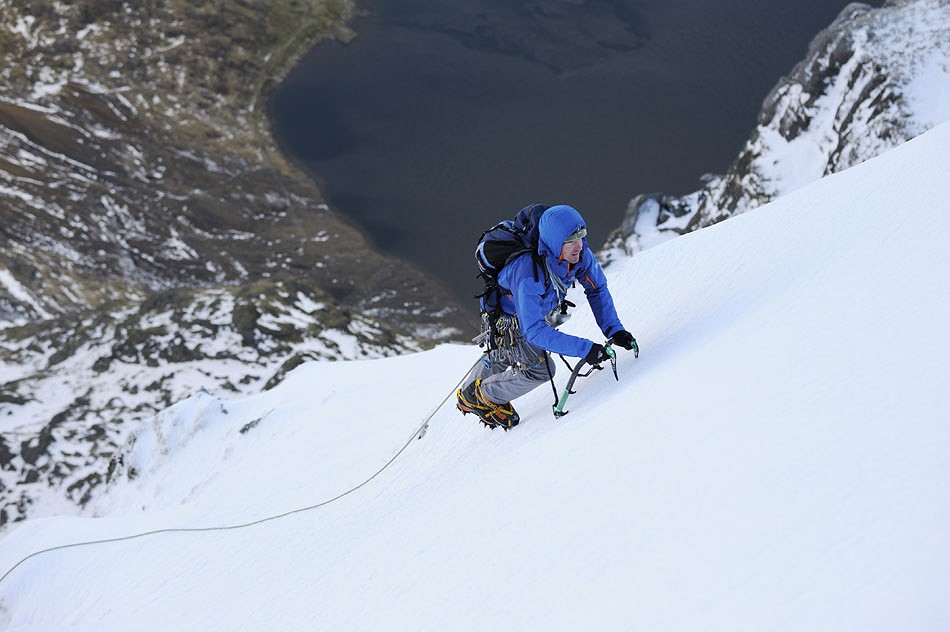
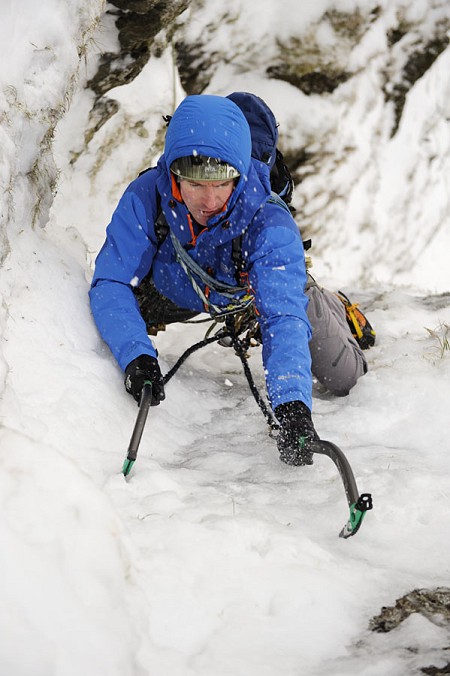
Picks:
For both the Fly and Apex, the picks and hammer or adze come as single piece units. While this has the disadvantage of having to replace the whole lot when the pick is worn, given that the replacement pick and hammer/adze units come in at an RRP of £35 - less pricey than many other manufacturers picks alone, the only time this would really present an issue would be if carrying a spare on a route – modern picks are incredibly tough and very hard to break so few it seems carry spares as standard these days. The main advantage of the single pick unit is that it gives much better connection (maximum surface area) of the pick to the axe – held in place by both bolts and the hammer/adze locking against the headset as opposed to the single bolt on other (split) designs. I've had no issues with picks loosening, and removing and replacing the picks is easy provided the bolts don't seize. Lastly, the picks hold their edge pretty well – surviving accidental rock strikes without blunting instantly.
Handle and spike:
The hot forged handle has an integral (flush to the shaft) solid plastic grip moulded into it – a great improvement on the simple (and often short-lived) rubber tube on the old Fly, and the slightly crude glued over the top design on the Rebel. The plastic is extremely tough – surviving crampon tapping (bad habits die hard) without visible damage though – presumably a durability tradeoff – the plastic isn't quite as 'sticky' as that on some of the competition. The grip is medium sized and a simple profile – no raised 'trigger' bump – so should work for most hand sizes and can be easily adapted with rubber tape to suit. Both the Fly and Apex come fitted with a well-designed removable (allen key supplied) chunky plastic handrest/guard. This gives excellent support and hand protection but it remains relatively small in profile so isn't too much of hindrance for plunging in soft snow. Fitting or removing the handrest is a 10 second job using one allen key that can easily be done on the hill if desired (e.g. for a long descent). The Apex also comes with a neat matching (removable) upper handrest solidly mounted into the top of the forged handle. The Fly comes drilled for the upper handrest, which can be purchased separately (RRP £10). Finishing the axes off is a traditional spike with a hole big enough to easily clip tethers etc. into.
The design of the bottom of the handle and spike is the only bit that draws some (very minor) criticism. First, the plastic grip doesn't extend all the way to the bottom of the grip area leaving a cold metal patch against the heel of the hand – though this is easily resolvable with a bit of self-amalgamating rubber tape (a roll of which comes supplied with the Apex for adding grip to the upper shaft). Second, the spike is just a bit big and straight – great for support walking, but very slightly in the way if wrapping the heel of the hand around the bottom of the handle when swinging the axe on steep ground.
Overall
Both the Apex and Fly feel very well-made, functional and inspiringly bombproof.
So, how do they climb?
Apex:
The Apex replaces the Rebel as DMM's top-end all-rounder, a hard act to follow as my Rebels are still going strong (paintwork excepted) after over 10km of climbing. Immediately noticeable when climbing – especially on steeper ground – is the huge pick clearance given by the very curved upper shaft. This curve is more pronounced than on most other manufacturers current 'traditional' (no offset handle) curved designs giving the Apex an extra cm or more of clearance. This extra clearance is a real bonus both climbing (e.g. letting more of the pick get deeper into turf over a bulge) and when daggering up easy ground – as it holds the hand higher up away from the snow. In fact, the Apex's curve almost exactly matches that of the Petzl Nomic and BD Fusion 2 – both very well proven on vertical and beyond ground. Hooking, the Apex feels very grabby and positive, and as the lower half of the shaft is pretty straight the shift in the pick angle when switching to the upper grip is intuitive and easy to adjust to.
At 635g (adze) and 620g (hammer) the Apex isn't the lightest out there, but is by no means hefty either. After disappearing for a while, removable pick-weights are now making something of a comeback – giving the ability to tweak the balance and swing. The Apex pick-weight (50g) is a simple design attached by a single bolt and stud – though it is a bit less usefully nut-shaped than the Petzl version. While balance and swing is a very personal thing, the Apex's feel very well balanced and have a great natural flick and swing – a tiny bit less head heavy than e.g. BD Vipers, but not as head light as the current Petzl Quark. With the headweights on the overall balance and action most resembles that of the original Quark – high praise indeed. Removing the pick weights makes a noticeable difference – lightening the feel (nice on pure snowed up rock) and making the axe swing a bit less 'flicky' – it's certainly worth experimenting with both.
Pic left: Apex overlain on Petzl Ergo (left), and DMM Rebel (right). The Apex has as much clearance as the Ergo at the head, and much more than the (still curved) Rebel. Aside from the offset handles, the Apex shaft aligns almost exactly with the Petzl Nomic and BD Fusion 2.
Pic right: Detail of Apex handle - handrests removed. Upper rest mounts solidy into the forged handle section while the lower rest is bolted onto the spike.
The T rated standard ice picks work well straight off the shelf – the beveled tip penetrates well and hooks edges securely, the low profile initial teeth make extraction easy, and the long front tooth will allow for a fair amount of sharpening. Towards the shaft, bigger teeth give good bite hooking flakes and chockstones. A serrated top edge gives stein-pull and crack torqueing bite, though will damage glove palms if used lots in walking mode. As with all very curved axes, the adze and hammer are to some extent blocked by the shaft and best used by holding the shaft about halfway up. The ice picks feature a small adze, serviceable for chipping verglas off small footholds, and the hammer is a simple low-profile design that while a little awkward serves its purpose if needed. Alternative, slightly steeper and thicker mixed picks are available, which also come in a 'Fly adze' variant for big adze fans, but the standard ice picks are probably the best all-round option with the business end working as well as anything out there.
Overall
The Apex is a seriously impressive go anywhere, do anything (and generally do it brilliantly) jack of all trades technical axe which is perfectly at home on all but the very hardest Scottish winter routes, valley icefalls and alpine lines – well done DMM.
Fly:
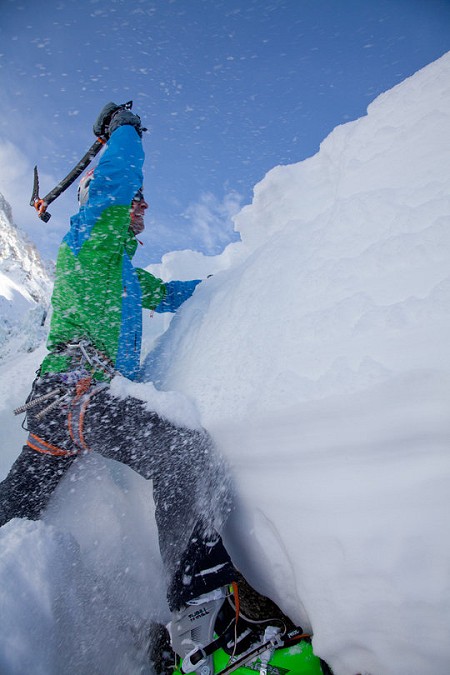
With the Fly, DMM have wisely stuck to the old adage – if it ain't broke, don't fix it – settling for updating the construction and features without messing around with the excellent original gentle curve and burly pick, hammer and adze. Although nowadays generally marketed as a low-to-mid grade all-rounder climbing axe, Fly's have proven their abilities on routes as hard as they come since introduced last century.
At 720 grams, the Flys aren't lightweights, but have a solid, well-balanced feel – the weight in the head gives them a burly, simple swing into ice or turf but as the weight is balanced between pick and adze/hammer they don't feel excessively head heavy and unwieldy when clearing snow or hooking on steep ground.
The beefy T-rated pick and big chunky adze and hammer are only slightly changed from the original design. The business end of the pick works well straight off the shelf – penetrating well for a reasonably chunky design, cleaning easily, and hooking well. At the other end of the pick, the 'top bump' has been slightly reduced and rounded for better comfort when holding the axe-head pick facing back – though they are still more comfortable held pick-forwards.
For those that find the hammers and adzes offered on most modern tools a bit weedy, the Fly keeps it's very effective big simple hammer, and big (any budding Mick Fowlers?) shovel-shaped adze – perfect for torqueing in fist cracks, clearing snow and ice, digging bucket seats and T-axe slots, or hacking through cornices. While the Fly's have much less pick clearance than the Apex, the gentle curve still makes a noticeable difference compared to a straight shaft, and unlike higher clearance axes, the shaft doesn't in any way restrict the easy use of the adze and hammer.
Rounding off the Fly's all-round credentials is that the headset (unchanged from the original) is shared with that of the mountaineering-orientated Raptor, allowing the classic curve Raptor pickset to be fitted if desired for e.g. summer alpine use.
Overall
The Fly remains as it was – a very capable all-round package perfect for everything from easy gullies and ridges, to classic mixed and ice routes and alpine faces.

About Viv Scott
I've been climbing for a bit over ten years, and am currently based in Edinburgh having escaped from the southern flatlands. Climbing highs include Scottish winter climbing, a couple of trips to the Alaska Range, classic alpine routes, sunny ski touring, cragging in the UK and abroad, and beers and craic in the pub afterwards. Lows include Scottish winter climbing, alpine bivies, base camp blues, midges and the UK weather... I guess I'd like to be a jack of all trades and I'm definitely a master of none, but most enjoy the great variety of climbing and look forward to trips back to old favourites and hopefully many new and different places.

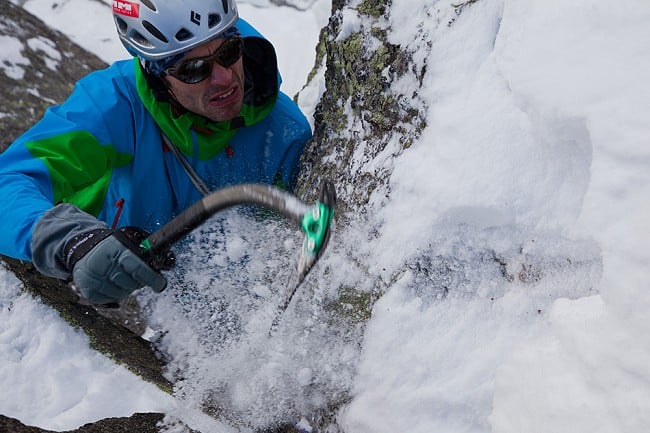
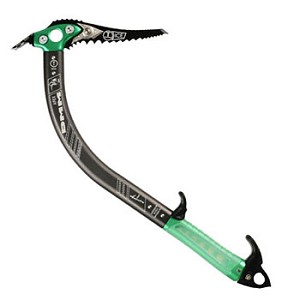
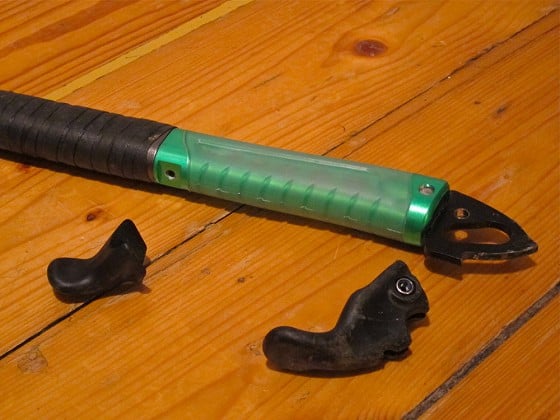

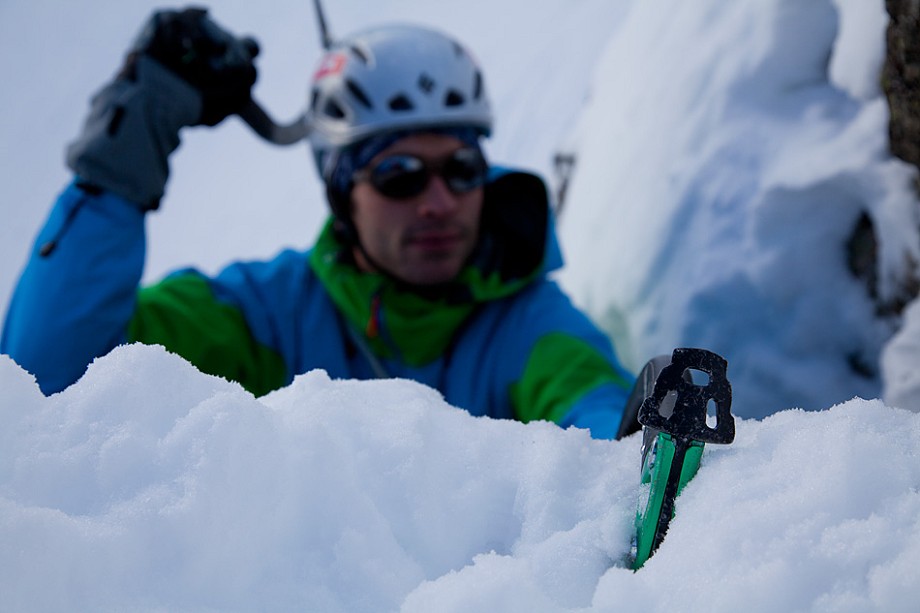
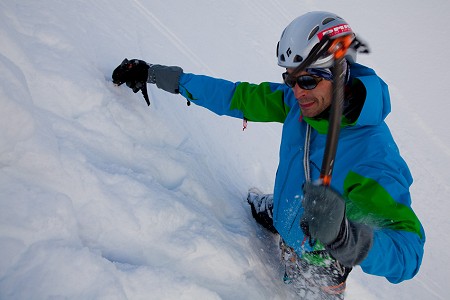

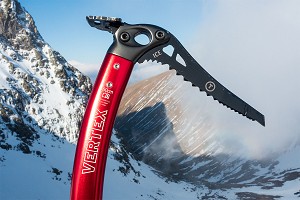
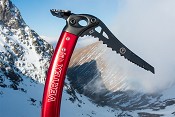

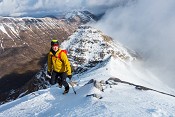
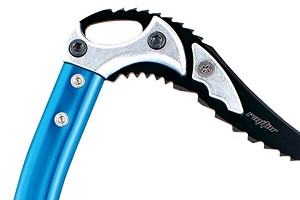
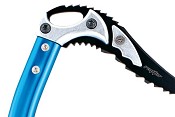
Comments